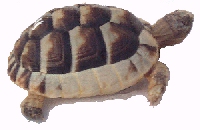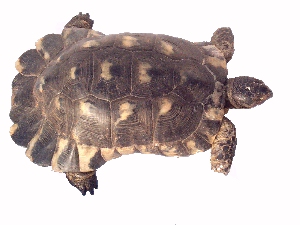|
Marginated Tortoise (Testudo marginata)
Coming from Greece the Marginated Tortoise represents the largest of the'Mediterranean Tortoises', achieving a total length of up to 325mm and weights up 4.5 kilo. This species is named because of the pronounced and flaring rear marginal scutes, which occurs in both sexes but is more pronounced in the male. Even amongst our adult males this 'skirt' varies in size (relative to the size of the individual anaimal) and shape, one of our males having a margin which is exteremly flared. Apart from the rear margin, the shape of the adults is elongated and when viewed from above the carapace appears as an elongated ovoid. The overall colour of the carapce is charcoal grey with the centre of the scutes retaining a cental beige to golden colour, though this gradually reduces in size with age. The plastron remains distinctive when adult and is a beige colur with an inverted dark brown triangle on each pair of scutes. Exposed skin areas on the adults is also dark grey but the softer skin varies from a cream to golden yellow colour.
Youngsters are very attractive, with each scute being light beige in the centre and gradually being surrounded by darker growth rings as they mature. Their skin tends to be a cream colour but exposed skin also darkens with age. Like adults, their plastron is distinctly marked with pairs of dark traingles which gradually become even more pronounced as they grow.
|
 A juvenile Marginated Tortoise
This image shows an 18 month old Testudo marginata. The carapace pattern is typical of this species and darkens with age.
A juvenile Marginated Tortoise
This image shows an 18 month old Testudo marginata. The carapace pattern is typical of this species and darkens with age. |
|
Hibernation
Hibernation has appeared necessary to maintain the health and high fertility of our stock. All fit animals are checked for a satisfactory body weight at the end of September. They are then cooled slightly by reducing the time of their heat lamps and fasted for a month to allow their digestive tract to fully empty. After this period all heat is removed and straw added to their indoor enclosure. This encourages the tortoises to settle and 'dig in'. Once torbid, each animal is maintained in it's own rodent proof insulated hibernation box which is well packed with straw. The boxes are then stored in a frost free environment at between 5 - 10 degrees celsius. Hibernation usually lasts from November until March although animals are still checked at monthly intervals. The animals awake as temperatures of above 12 degrees celsius are achieved, they are then bathed in water and replaced into their indoor accommadation pen with full heat lamps. Their appetites return almost immediately, though we hydrate them by feeding Romaine lettuce (a favourite food). The high water content assists each animal to pass stored toxins as we have found this species reluctant to drink water even when bathed.
|
|
Management
Our colony of Marginated have proved to be very rewarding and responsive pets, with bold, friendly and distinctive characters, especially our oldest male of some 40 years. With the correct facilities they are an easy species to manage being adaptable and willing to accept a varied diet. Ours are housed with an indoor section with the facility for a basking heat lamp when the British summer weather is inclement. from these quarters they have access to a south facing, open ended mini greenhouse, which also provides natural basking opportunities. This in turn leads to a large grazing area which provides natural grazing of mixed grasses(which other Mediterranean species seem reluctant to eat), dandelions, plantains and clover. This are is also landscaped with limestone rocks and Mediterannean plant speices i.e. Fan palm, succulents, lavander,rosemary and horizontal junipers. Our colony is divided with separate accommadation for adult males. this has proved necessary as the males are very amourous to the point of harassing the females and fighting. this separation has also proved sucessful to maintain each animal's condition and facilitates selection of our choice males for breeding.
Breeding
We have found our marginated very easy to breed provided they are correctly maintained. males are placed with feamles once a month during the summer but monitored closely as coutship can be very agressive and stressful for females - hence separate accommadtion. Our femles lay at the far end of their enclosure in a greenhouse with a prepared area of mixed soil and sand. Females become restless prior to laying and tend to gain an additiona; 300gms in weight. Laying takes place mainly in the afternoon after the female has dug a flask shaped hole in the ground. The eggs are white an about the size and sahpe of a small table tennis ball. Once the nest has been covered the eggs are removed to our still air incubator and set at 32 degrees farenhiet and 75% relative humidity. Eggs hatch at an average of 65 days but this often varies 5 days either side of this figure even within the same clutch. We have found our Marginated to be highly fertile and achieve a hatch rate close to 95% with clutches of up to 12 eggs.
HATCHLINGS AVAILABLE FROM MAY AT £125 EACH (see contact page)
|
 Carapace of male Marginated Tortoise
This shows an adult male about 310mm in length and weighing 4 kilo. The carapace shows the typical patterns and pronounced flaring for which the species in named.
Carapace of male Marginated Tortoise
This shows an adult male about 310mm in length and weighing 4 kilo. The carapace shows the typical patterns and pronounced flaring for which the species in named. |